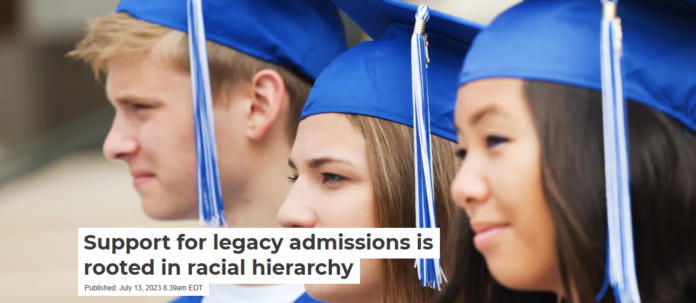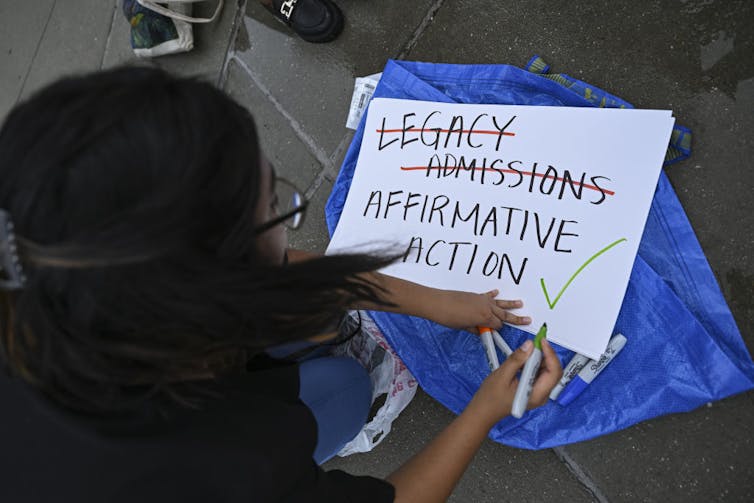

Angelica S. Gutierrez, Loyola Marymount University
Not long after the U.S. Supreme Court’s June 2023 decision to ban the use of race in college admissions, people began to ask questions once again about the fairness of legacy admissions.
Legacy admission is a practice in which colleges give a preference to the children of graduates when deciding which students to let in.
As a researcher who specializes in education and workplace policies, I have examined why people support legacy admissions and not affirmative action. I found that even though legacy admissions are based on parental connections to a given school, support for the policy actually has something to do with race.
Race is at the heart of a complaint that Black and Latino community groups filed against Harvard University just days after the court’s 6-3 ruling against affirmative action. The groups filed the complaint with the U.S. Department of Education’s Office of Civil Rights. The complaint argues that legacy admissions are tantamount to racial discrimination because Harvard grants preferential treatment to legacies – 70% of whom are white. The complaint alleges that Harvard’s use of legacy admissions therefore violates Title VII of the Civil Rights Act of 1964, which prohibits racial discrimination in institutions that receive federal funds.
The groups – the Chica Project, African Community Economic Development of New England and the Greater Boston Latino Network – are among the growing number of those who question the double standard that lurks behind legacy admissions. And that is: Why can family ties be considered in the college admission process, but not race?

Examining rationales
As a researcher, I began to probe people’s attitudes about legacy admissions – and whether the practice is fair – over a decade ago. I found that those who support legacy admissions do so in part because they want to maintain a racial hierarchy. In this hierarchy, white Americans are the dominant group, and ethnic minorities are subordinates.
Dominance is based on group access to resources that have positive social value. These resources include power, status and prestige. Relative to ethnic minorities, white Americans have higher levels of wealth, education and labor market participation. They also occupy more positions of authority.
To examine people’s beliefs about racial hierarchy and how much they support it, I used a construct called social dominance orientation. Researchers have described social dominance orientation as the degree to which individuals support a group-based hierarchy and the domination of “inferior” groups.
Those who seek to maintain the hierarchy will support policies that benefit the dominant group. Similarly, they will oppose policies that they believe threaten the hierarchy by benefiting ethnic minorities.
Taking a closer look
I used social dominance orientation in two different studies to examine people’s attitudes toward legacy admissions versus affirmative action. In the first study, I recruited 80 UCLA students from an online database maintained by the university. Of that group, 38 were Asian, 36 were white, four were Latino and two were multiracial.
I first measured social dominance orientation by asking participants to rate how positively or negatively they felt about the eight statements in the social dominance orientation scale. Examples of the statements include: “It’s probably a good thing that certain groups are at the top and other groups are at the bottom.” Another one is: “Some groups are simply inferior to other groups.”
After completing the measure, participants were randomly assigned to review either a legacy policy or an affirmative action policy. I then measured participants’ policy support by asking them to rate how strongly they agreed or disagreed with various statements about the policy that they were assigned to review. One statement was: “This admissions policy will help admit highly qualified individuals.” Another statement was: “To what extent do you agree or disagree that this policy is legitimate and should be continued?”
Just as was found in previous research, I found that people who wanted to maintain social dominance for white people were largely the same people who supported legacy admissions. They also largely opposed affirmative action.
These findings are consistent with the idea that individuals who seek to maintain the existing hierarchy will not support a policy that benefits ethnic minorities. However, they will support a policy that benefits the dominant group. This is relevant to the discussion of legacy admissions because members of the dominant group – in this case, white Americans – are more likely to have parents who went to college.

Underlying motives
In the second study, I took a closer look at support for legacy admissions. Even though Asian American and white American students were supportive of legacy admissions in the first study, I couldn’t establish why. Both Asian Americans and white Americans were the majorities in the student population at UCLA – 37% and 32%, respectively – so it was unclear whether their support for legacy admissions reflected a desire to maintain the existing hierarchy or self-interest. In other words, it was possible that both Asian American and white American students supported legacy admissions not because they wanted to uphold the hierarchy. Rather, their support could have been because both groups believed their children and grandchildren would benefit from the policy in the future.
To better determine the underlying motivation for support of legacy admissions, in the second study I examined only the views of Asian Americans. Fifty-four self-identified Asian students participated.
Consistent with the first study, I first measured participants’ social dominance orientation. I then randomly assigned participants to read about legacy admissions that would benefit either Asian Americans or white Americans. Half the participants received an admissions excerpt that concluded: “Because legacy policies improve the admissions prospects for alumni children, Asians will be the primary beneficiaries.” For the other half, the excerpt concluded: “Because legacy policies improve the admissions prospects for alumni children, whites will be the primary beneficiaries.” I then measured participants’ support for the legacy policy by using the same items from the first study.
If Asian Americans supported legacy admissions in the first study simply because they believed that their children and grandchildren would benefit from this policy in the future, then in the second study we would have seen support for the use of legacy admissions when they read that the policy would benefit Asian Americans. Instead, I found that support is driven not by self-interest but a desire to maintain the hierarchy. The results revealed that Asian Americans supported legacy admissions only when white Americans were the perceived beneficiaries. There was no significant support for legacy admissions when Asian Americans were the perceived beneficiaries.
In all, the results show that support and opposition to policies doesn’t depend on the actual policies. Rather, it depends on the perceived effect the policies will have on the racial hierarchy.
The quest for equality
Policies like affirmative action can level the playing field and increase access to college for historically excluded groups. However, legacy admission policies can maintain the hierarchy because they disproportionately benefit white people – the historically advantaged group.
Now that consideration of race in college admissions has been banned, universities have an opportunity to revamp how they decide which students to admit. In writing for the majority, Justice John Roberts noted that the Constitution requires schools to be colorblind. He wrote that a student “must be treated based on his or her experiences as an individual – not on the basis of race.” But if colorblind is the standard, do legacy admissions meet it? Based on my analysis of the evidence, the answer would have to be no.
Angelica S. Gutierrez, Professor of Management, Loyola Marymount University
This article is republished from The Conversation under a Creative Commons license. Read the original article.



















